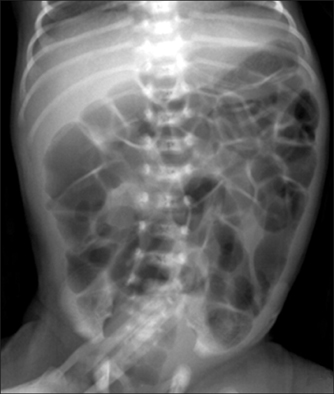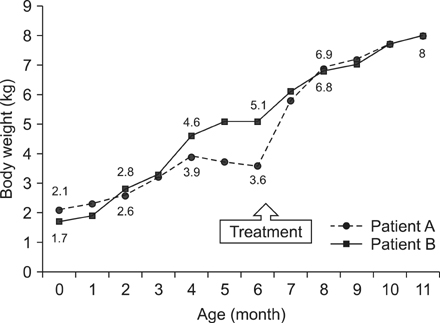Pediatr Gastroenterol Hepatol Nutr.
2013 Sep;16(3):195-199. 10.5223/pghn.2013.16.3.195.
Congenital Chloride Diarrhea in Dizygotic Twins
- Affiliations
-
- 1Department of Pediatrics, College of Medicine, Chung-Ang University, Seoul, Korea. piena81@hotmail.com
- 2Department of Obstetrics and Gynecology, College of Medicine, Chung-Ang University, Seoul, Korea.
- KMID: 2051334
- DOI: http://doi.org/10.5223/pghn.2013.16.3.195
Abstract
- Congenital chloride diarrhea (CLD) is a rare inherited autosomal recessive disorder. Mutations of the solute carrier family 26 member 3 gene cause profuse, chloride ion rich diarrhea, which results in hypochloremia, hyponatremia and metabolic alkalosis with dehydration. If a fetal ultrasound shows bowel dilatation suggestive of bowel obstruction, or if a neonate shows persistent diarrhea and metabolic alkalosis, CLD should be considered in the differential diagnosis. The severity of CLD varies, but early detection and early therapy can prevent complications including growth failure. We report a case of dizygotic twins affected by CLD who had been born to non-consanguineous parents. Both of them showed growth failure, but one of the twins experienced worse clinical course. He showed developmental delay, along with dehydration and severe electrolyte imbalance. He was diagnosed with CLD first at 6-month age, and then the other one was also diagnosed with CLD.
MeSH Terms
Figure
Reference
-
1. Norio R, Perheentupa J, Launiala K, Hallman N. Congenital chloride diarrhea, an autosomal recessive disease. Genetic study of 14 Finnish and 12 other families. Clin Genet. 1971; 2:182–192.2. Moseley RH, Höglund P, Wu GD, Silberg DG, Haila S, de la Chapelle A, et al. Downregulated in adenoma gene encodes a chloride transporter defective in congenital chloride diarrhea. Am J Physiol. 1999; 276:G185–G192.3. Hihnala S, Höglund P, Lammi L, Kokkonen J, Ormälä T, Holmberg C. Long-term clinical outcome in patients with congenital chloride diarrhea. J Pediatr Gastroenterol Nutr. 2006; 42:369–375.
Article4. Mäkelä S, Kere J, Holmberg C, Höglund P. SLC26A3 mutations in congenital chloride diarrhea. Hum Mutat. 2002; 20:425–438.
Article5. Yoshikawa H, Watanabe T, Abe T, Sato M, Oda Y. Japanese siblings with congenital chloride diarrhea. Pediatr Int. 2000; 42:313–315.
Article6. Rodríguez-herrera A, Navas-lópez VM, Redondo-nevado J, Gutiérrez G. Compound heterozygous mutations in the SLC26A3 gene in 2 Spanish siblings with congenital chloride diarrhea. J Pediatr Gastroenterol Nutr. 2011; 52:106–110.
Article7. Kim SH, Kim SH. Congenital chloride diarrhea: antenatal ultrasonographic findings in siblings. J Ultrasound Med. 2001; 20:1133–1136.
Article8. Imada S, Kikuchi A, Horikoshi T, Ishikawa K, Tamaru S, Komatsu A, et al. Prenatal diagnosis and management of congenital chloride diarrhea: a case report of 2 siblings. J Clin Ultrasound. 2012; 40:239–242.
Article9. Höglund P, Holmberg C, Sherman P, Kere J. Distinct outcomes of chloride diarrhoea in two siblings with identical genetic background of the disease: implications for early diagnosis and treatment. Gut. 2001; 48:724–727.
Article10. Patel PJ, Kolawole TM, Ba'Aqueel HS, al-Jisi N. Antenatal sonographic findings of congenital chloride diarrhea. J Clin Ultrasound. 1989; 17:115–118.
Article11. Wedenoja S, Höglund P, Holmberg C. Review article: the clinical management of congenital chloride diarrhoea. Aliment Pharmacol Ther. 2010; 31:477–485.
Article12. Lok KH, Hung HG, Li KK, Li KF, Szeto ML. Congenital chloride diarrhea: a missed diagnosis in an adult patient. Am J Gastroenterol. 2007; 102:1328–1329.
Article13. Pieroni KP, Bass D. Proton pump inhibitor treatment for congenital chloride diarrhea. Digest Dis Sci. 2011; 56:673–676.
Article14. Canani RB, Terrin G, Cirillo P, Castaldo G, Salvatore F, Cardillo G, et al. Butyrate as an effective treatment of congenital chloride diarrhea. Gastroenterology. 2004; 127:630–634.
Article15. Gamble JL, Fahey KR, Appleton J, MacLachlan E. Congenital alkalosis with diarrhea. J Pediatr. 1945; 26:509–518.
Article16. Darrow DC. Congenital alkalosis with diarrhea. J Pediatr. 1945; 26:519–532.
Article17. Lee YD, Lee HJ, Moon HR. Congenital chloridorrhea in Korean infants. J Korean Med Sci. 1988; 3:123–129.
Article18. Yoon SK, Kim EY, Moon KR, Park SK. A case of congenital chloride diarrhea in premature infant. J Korean Pediatr Soc. 2003; 46:308–311.19. Lee ES, Cho AR, Ki CS. Identification of SLC26A3 mutations in a Korean patient with congenital chloride diarrhea. Ann Lab Med. 2012; 32:312–315.
Article20. Hong J, Seo JK, Ko JS, Cheong HI, Choi JH, Lee JH, et al. Congenital chloride diarrhea in Korean children: novel mutations and genetic characteristics. Eur J Pediatr. 2013; 172:545–550.
Article
- Full Text Links
- Actions
-
Cited
- CITED
-
- Close
- Share
- Similar articles
-
- A case of down's syndrome in twins of unlike sex
- Two Cases of Collodion baby in Dizygotic Twins
- A Case of Apert Syndrome Expressed On One Neonate of Dizygotic Twin
- Second trimester selective termination in a dizygotic twin pregnancy with discordancy for Down's syndrome: A case report
- A Case of Congenital Chloride Diarrhea in Premature Infant




